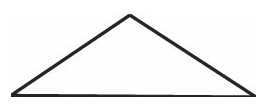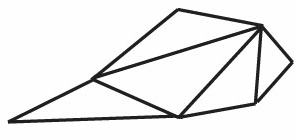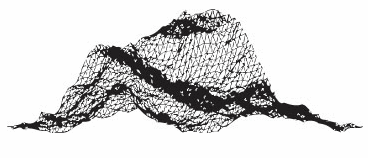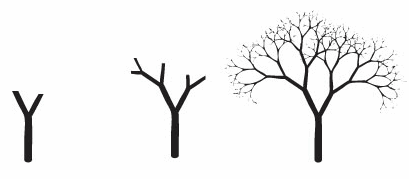Dziwne doprawdy bywają zbiegi okoliczności. A może to zbiegowie a nie zbiegi? Zbieg – zbiegi, a na pierwsze (a może na drugie?) imię mam Zbigniew. Hmmm.... Do poduszki czytuję rózne takie książki. Akurat na tapecie mam „Altar of Eden” Jamesa Rollinsa.

Autor jest z wykształcenia weterynarzem i w jego książkach mamy plagi, epidemie, inżynierię genetyczną, no i konspirację wszelkiego rodzaju. Amerykańskiego Departamentu Obrony autor nie oszczędza. Główny bohater to zazwyczaj weterynarz lub weterynarka, ale z tych naprawdę dobrze wykształconych. Jest to druga książka tego autora, którą czytam.
Więc tak sobie czytam i nagle: Zbieg Okoliczności. Bo przecież pracuję nad książką o fraktalach a tu, raptem, trafiam na taki fragment:
Are you familiar with fractals?”
Again Lorna was taken aback by the non sequitur. What is this guy talking about? Still, at the same time, she recalled hearing that word before. Her brother had used it in reference to the pattern of magnetite crystals found in the dissected feline brain. She knew something about fractals, but nothing beyond the basics—and definitely not how fractals were involved here.
She merely shook her head, wanting to hear what the researcher had to say.
“Ah, well, by definition, fractals are jagged, irregular geometric forms generated by a repeated pattern of that same shape. Or in other words, they’re large shapes that can be broken down into smaller and smaller versions of itself.”
Lorna frowned. She remembered Jon Greer’s description of the magnetite nodes in the animals’ brains, how the matrix was made up of smaller and smaller crystals.
“I see you’re confused. Let me show you what I mean,” Malik said and tapped at his computer keyboard. To Lorna’s right, one of the monitors bloomed to life. “All geometric shapes can be defined by a single algorithm or mathematical equation. Here’s a rather simple one.”

It was just an ordinary triangle.
Malik tapped again. “But if you have the computer multiply it several times, adding one to another, it grows to this.”

On the screen, several of the triangles—positioned at various angles and on different planes—now formed a complex polygon. She shrugged, unimpressed.
“I know,” Malik conceded. “Not much to look at, but let’s have the computer take that same triangle and repeat it a hundred thousand times, shrinking some, enlarging others, changing inclination, but basically just repeating the same triangle over and over again. Here is what you get.”

No, w porządku. Mamy fraktale, mamy trójkąty, mamy triangulację powierzchni. Nad tym wszystkim aktualnie pracuję. A konkretnie, pracuję na programem liczącym wymiary fraktalne, a testuję na trójkącie Sierpińskiego. Ale to jeszcze małe piwo. Bo co mamy dalej? Oto co:
Lorna’s eyes widened. “It’s forming a mountain range.”
“Exactly. A landscape composed of millions of repetitions of the same shape. In this case, triangles. This is how computers today generate such detailed backgrounds in movies and video games. Just countless repetitions of the same basic algorithm or fractal to produce a more complex one.”
“But what does all this have to do with—”
Malik cut her off. “Because this phenomenon isn’t just found in mountains and coastlines. It’s found throughout the natural world. Take a tree, for example. If you look at the branching of any tree, it’s just a repetition of the same basic pattern, unique to that species of tree.”
On the screen, she watched a simple shape appear: a single line with two branching offshoots, forming a Y Then more and more Y shapes branched out from the first and multiplied into a fully dimensional tree.

“This same fractal basis of the natural world is found everywhere. From the structure of galaxies down to the tiniest snowflake, from the flow of ocean currents up to the shape of clouds in the sky. It’s all around us and in us.”
“In us?”
“Fractals make up our bodies. They can be found in the growth of blood vessels, the pattern of alveoli in our lungs, the shape of our kidneys, even the branching of the dendrites in our brain. But it’s so much more than that. When you look deeper, they’re even in the way our bodies function. It’s been shown that fractals define how we walk, the beating pattern of our hearts, the rates of respiration of our lungs. Likewise, scientists are now using fractal science to evaluate brain function, studying the fractal pattern hidden within EEGs. And they found it.”
Malik must have noted the look on her face and smiled. “That’s right. Some neurophysiologists are even coming to believe that the evolution of intelligence grew from fractals. That intelligence came about because of the repetitious growth of a smaller constant. In other words, there might be a fundamental fractal of intelligence, a primary seed from which all intelligence grew. Similar to that sprouting tree I just showed you. Can you imagine if we could harness that fractal, learn to control that power?”
Lorna thought back on the animals from the trawler and their strange intelligence. “That’s what you’ve been experimenting on. You’re looking for that fractal?”
Ale to jeszcze małe piwo. Bo co mamy dalej?
Lorna stood with Dr. Malik before one of the wall monitors. On the screen rotated a three-dimensional scan of a brain. It reminded her of the MRI done on Igor’s brain. After all the bloodshed and fire, that seemed a lifetime ago. She tried to concentrate on Malik’s explanation, but a pall of grief and defeat weighed her down. The doctor’s words sounded hollow and distant.
“Here is the best image we could muster of the brain anomaly found in the test subjects.”
Malik pointed a finger at the five nodes on the screen, colored a distinct blue to distinguish them from the surrounding gray cerebral tissue. The number and pattern of the nodes were identical to those discovered during Igor’s MRI back at her lab. But Malik’s scan had much better resolution. Not only did the nodes stand out crisply, but so did the fine branching of magnetite crystals that connected the nodes together.
As it rotated, the pattern looked to have the same crystalline structure and shape as a snowflake.
“Are you familiar withfractal antennas?” Malik asked.
Lorna fought through her despair to answer. It took her an extra beat to croak out a “No.”
“Do you own a cell phone?”
The strange question pierced the fog in her head. Curiosity focused her sharper. “Of course.”
“Then you already own a fractal antenna. In the last decade, scientists have learned that antenna arrays patterned after fractals have an amazing ability to broadcast along a wider range of frequencies with a greater strength-to-size ratio. This breakthrough allowed manufacturers to shrink antennas down to microscopic sizes, yet still function like antennas a hundredfold larger. It’s revolutionized the industry. That’s the power hidden within fractals.”
Malik pointed to the screen. “And that’s what we’re looking at here. A fractal antenna grown from natural magnetite crystals in the brain.”
Lorna studied the snowflakelike pattern and remembered her own crude analogy to a satellite dish. She also recalled the strange synchronization of EEGs. “And it’s this fractal antenna that allows the animals to link up neurologically.”
“Exactly. The pattern of magnetic crystallization seen here is definitely fractal in nature. The entire neural matrix is made up of the repetition of the same basic crystal shape.”
“Like the triangle multiplying into a mountain.”
Malik nodded. “But this is only the tip of that mountain. Initially this scan was the best we could discern using standard techniques. Such methods only allowed us to look so far. Even zooming down with an electron microscope only revealed a crystal made up of hundreds of even tinier crystals. It was like with those Russian nesting dolls. Every time you thought you’d reached the smallest crystal, it would open up to reveal even smaller versions of itself inside. It went on and on— stretching beyond our ability to detect.”
Malik’s voice cracked with frustration. Lorna remembered the raw desire in the researcher’s eyes as he described his search for a fundamental fractal that was the root of all intelligence.
“No matter how hard we looked, the primary fractal kept retreating out of reach, growing smaller and smaller, eventually disappearing beyond where we could scan, down a spooky hole no one dared follow.”
Lorna pictured the white rabbit from Alice in Wonderland bounding down his rabbit hole.
“And though we weren’t able to go down that hole, I could guess what was down there.”
Lorna’s interest piqued sharper. “What?”
“The strange world of quantum physics. Following fractals smaller and smaller, it eventually leads to the subatomic world. In fact, some physicists now believe that the science of fractals could explain away some of thespookiness of quantum theory. Such things likenonlocality and entanglement, how a subatomic particle can be at two places at once, how light behaves both like a wave and a particle. When you get that small, things get weird. Butfractals may hold the answer to explaining it all.”
No, to wesoło. A ja przecież pracuję na kwantowymi fraktalami, te zaś są związane z wyjaśnieniem tajemnic procesu pomiaru w teorii kwantów! Czy może moja fraktalna kwantowa antena w moim mózgu odbiera jakieś nielokalne sygnały z przyszłości i dlatego wybrałem do czytania tę a nie inną książkę?A skąd się ta książka w moich rękach wzięła. Otóż Laura zamówiła jakiś miesiąc czy dwa temu, nie wiem nawet z jakiego powodu, jedną książkę Rollinsa. Przeczytaliśmy, spodobała nam się, więc zamówiła następne trzy. Z tych trzech wybrałem tę jedną do czytania. Tzn. najpierw zacząłem czytać inną, ale wydawała mi się zbyt podobna do tej pierwszej, więc odłożyłem i wziąłem „Ołtarz Edenu”. A tam fraktal na fraktalu!
Oczywiście statystyk powie: „zbieg okoliczności”. Co oznacza mniej więcej: „nie mam wyjaśnienia, i to jest mój sposób powiedzenia właśnie tego że nie mam wyjaśnienia”.
Ja też nie mam wyjaśnienia. Ale mam hipotezę: fraktale w mózgu i u podstaw Bytu za tym stoją!










Komentarze